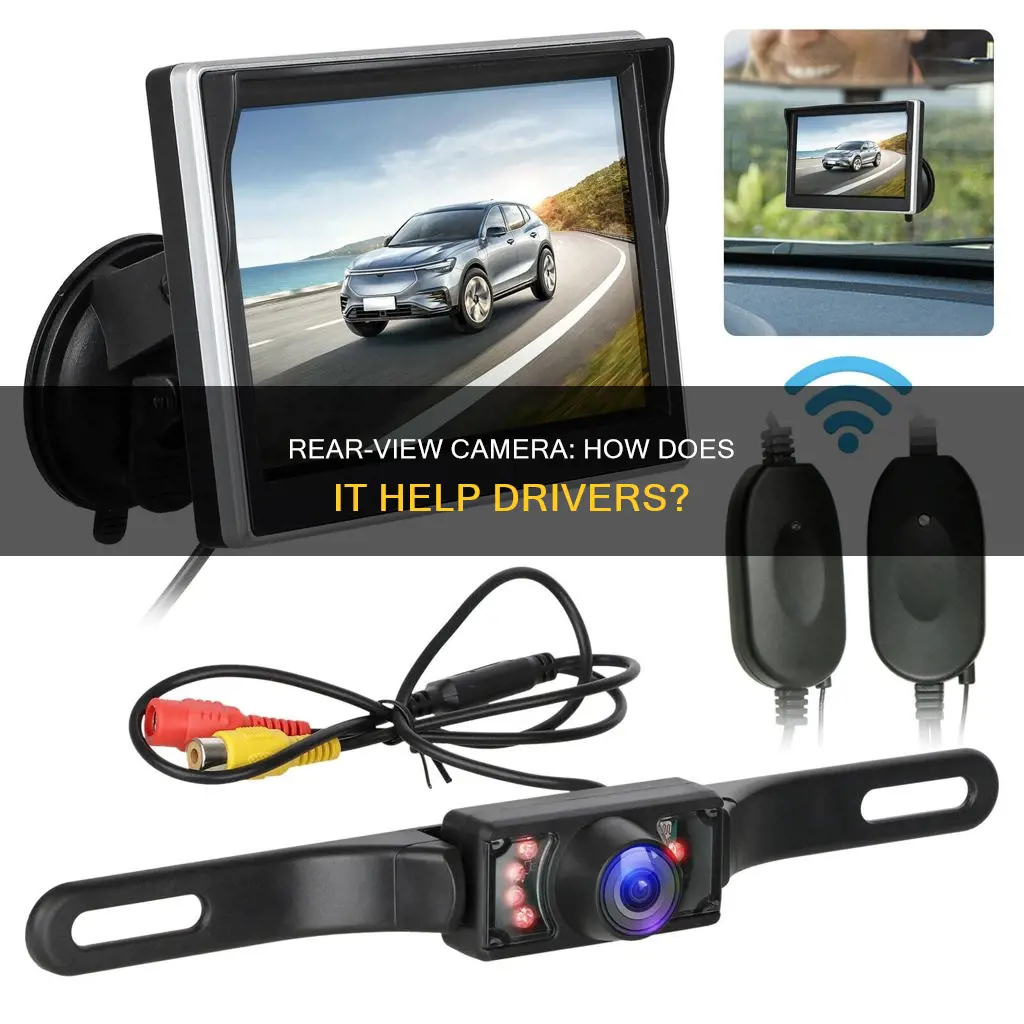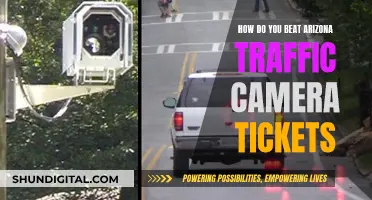
Rear-mounted cameras, also known as backup cameras, are now a legal requirement for all new vehicles weighing less than 10,000 pounds. These cameras are designed to help drivers see what's directly behind their car, below the level of the rear window, and to eliminate blind spots. They can also be extremely useful when parking, giving the driver a clearer view of obstacles and warning them when they're getting too close.
| Characteristics | Values |
|---|---|
| Purpose | To help avert injury-causing and potentially fatal backover accidents by expanding the driver's field of vision, particularly below the rear window or trunk level |
| Other Benefits | Help with parking, eliminate blind spots, protect property behind the vehicle |
| Installation | Can be installed by purchasing a mountable backup camera for your specific vehicle, an external monitor, an internal monitor, and power and video cords |
| Installation Time | One hour |
| Installation Skill Level | Beginner |
What You'll Learn
- Rear-mounted cameras are now legally required in all new vehicles under 10,000 pounds
- They help to prevent backover accidents, which cause 210 deaths per year
- Cameras can be flush-mounted, bracket-mounted, or embedded in a license plate frame
- They are typically hidden in the bumper, near the license plate, or in the trunk lid
- Monitors can be mounted on the dashboard, on the windshield, or in the rearview mirror

Rear-mounted cameras are now legally required in all new vehicles under 10,000 pounds
As of May 2018, federal law has required that all new vehicles weighing less than 10,000 pounds be equipped with rearview monitoring technology, which usually means rear-mounted cameras. This is a significant development in automotive safety, addressing a key shortcoming of traditional rearview mirrors: their limited field of vision.
The Benefits of Rear-Mounted Cameras
Rear-mounted cameras help drivers see what's directly behind their car below the level of the rear window, and they also provide a wide-angle view. This expanded field of vision helps to avert injury-causing and potentially fatal backover accidents, which, according to government statistics, result in about 210 deaths and 15,000 injuries every year, with 31% of those fatalities involving children under the age of 5.
In addition to enhancing safety, rear-mounted cameras offer a number of other advantages. They can assist with parking, making it quicker and safer by providing a clearer view of obstacles. Most backup camera systems also include warning tones that alert drivers when they are too close to an object. The cameras also feature on-screen guidelines to help direct drivers into or out of parking spaces, and some even have a middle line to keep the vehicle centred.
Installation and Functionality
Installing a rear-mounted camera typically involves positioning the camera on the vehicle, marking where the camera's cord hits the vehicle, and drilling a hole to run the camera wiring through. The camera is then attached to the vehicle using supplied hardware or separately purchased hardware.
When a car is put into reverse, the rear-mounted camera turns on and sends an image to a monitor, often located in the centre area of the cockpit or built into the rearview mirror. The image captured by the camera is a mirror image, ensuring the orientation is correct for the driver.
Limitations and Considerations
While rear-mounted cameras offer significant benefits, they are not a perfect solution. One common issue is poor image quality, often due to a dirty lens, as many cameras are mounted low on the back of the car and can be obscured by mud, snow, or debris. Additionally, wireless systems may experience interference or pairing problems.
It is also important to note that backup cameras do not guarantee safety and should be used in conjunction with mirrors and turning around to look. According to a National Highway Traffic Safety Administration study, the number of vehicles with backup cameras more than doubled over a three-year period, but the number of injuries was reduced by less than 8%. However, the fatality rate from these types of accidents fell by more than 30%.
In conclusion, while rear-mounted cameras are now legally required in all new vehicles under 10,000 pounds, it is essential to use them in conjunction with other safety measures and remain vigilant while driving.
Charging Your YI 4K Camera: How Long Does It Take?
You may want to see also

They help to prevent backover accidents, which cause 210 deaths per year
Rear-mounted cameras, also known as backup or rearview cameras, are designed to help drivers avoid backover accidents, which are common when a vehicle is exiting a parking spot or driveway. These accidents often involve toddlers and children under the age of 5, who are in the car's blind zone. Backover accidents result in around 210 deaths per year, with 31% of those fatalities involving children under the age of 5.
Rearview mirrors have been a standard feature of motor vehicles for over a century, but they have limitations. They don't provide a view of what's directly behind the car below the rear window, and they don't offer a wide-angle perspective. This can make it difficult for drivers to see small children or objects behind the vehicle when backing up.
Rear-mounted cameras address these issues by expanding the driver's field of vision. They are typically mounted at the rear of the vehicle, often near the license plate or in the trunk lid, and angled downward to provide a clear view of the area immediately behind the car. The camera feed is displayed on a monitor in the driver's field of vision, usually in the center of the cockpit, allowing drivers to see any obstacles or pedestrians in their path.
In addition to preventing backover accidents, rear-mounted cameras offer other benefits. They can assist with parking by providing guidelines and warning tones to help drivers navigate into or out of parking spaces. They are also useful when towing a trailer, as they provide a close-up view of the trailer and hitch.
While rear-mounted cameras are a valuable safety tool, they should not be solely relied upon. Drivers should also use their mirrors, turn around to look, and be aware of their surroundings to prevent accidents.
Overall, rear-mounted cameras are an important feature that can help reduce the number of backover accidents and enhance the safety of both drivers and pedestrians.
Surveillance Cameras: Legal to Spy on New York Neighbors?
You may want to see also

Cameras can be flush-mounted, bracket-mounted, or embedded in a license plate frame
There are several ways to mount a rear-facing camera on a car. One common method is to use a license plate bracket, which allows for quick and easy installation by attaching the camera directly to the license plate screws. This type of mount is compatible with a variety of camera systems and can be used for both front and rear-facing cameras. Alternatively, cameras can be flush-mounted or bracket-mounted, providing a more permanent solution. Flush-mounted cameras are integrated into the vehicle's rear trim pieces, resulting in a sleek and unobtrusive appearance. Bracket-mounted cameras, on the other hand, may require drilling holes and additional tools for installation but offer a secure and adjustable mounting option.
When choosing a mounting option, it is important to consider the compatibility of the camera and vehicle, as well as the desired level of adjustability and permanence. For those seeking a simple and versatile solution, a license plate bracket mount is an excellent choice. However, for a more seamless and integrated look, flush-mounting or bracket-mounting may be preferred. It is worth noting that some vehicles, such as SUVs or pickup trucks, may have unique considerations due to their rear design, including the presence of a liftgate or tailgate.
In addition to mounting options, there are several other factors to consider when installing a rear-facing camera. The angle and position of the camera are crucial to ensuring an optimal field of vision. Cameras should be aimed at a downward angle to provide the best view immediately behind the vehicle, and they should be positioned to avoid obstructions such as defroster lines. Additionally, the camera's image quality, night vision capabilities, and compatibility with the vehicle's display system are important factors to keep in mind.
Overall, the mounting option chosen will depend on the specific needs and preferences of the vehicle owner. Whether it be a license plate bracket, flush-mount, or bracket-mount, each option offers unique advantages in terms of ease of installation, adjustability, and aesthetics. By selecting the appropriate mounting method and considering the camera's functionality and placement, vehicle owners can enhance their safety and visibility when driving or parking.
Mastering HP Camera Operation: A Step-by-Step Guide
You may want to see also

They are typically hidden in the bumper, near the license plate, or in the trunk lid
Rear-mounted cameras, also known as backup cameras, are typically hidden in the bumper, near the license plate, or in the trunk lid. They are designed to be fairly unobtrusive, so they can be a bit challenging to spot. However, their presence is essential for enhancing safety and providing drivers with a clearer view of their surroundings.
When installing a rear-mounted camera, it is common to remove the rear license plate and interior trunk panel to access the wiring and mounting locations. Drilling a small hole in the license plate mounting area allows the camera's power and video cable to be fed into the trunk. This cable is then connected to the camera, which is mounted on or near the license plate.
The camera's video cable is routed to the front of the car, often by peeling back the headlining or side panels. The power source for the camera is typically the reverse or license plate light, with the positive and negative wires spliced or connected using a Posi-Tap.
To ensure a clean installation, it is recommended to pair and route the camera wiring alongside the existing manufacturer wiring loom. This helps to maintain a neat appearance and prevents wires from dangling or being exposed.
Overall, the process of installing a rear-mounted camera involves careful drilling, wiring, and mounting, ensuring that the camera is securely attached and connected to the vehicle's power and display systems.
Mastering Camera Focus Lock: A Photographer's Guide
You may want to see also

Monitors can be mounted on the dashboard, on the windshield, or in the rearview mirror
Monitors for rear-mounted cameras can be placed in a few different spots in a car. The most common places are on the dashboard, on the windshield, or in the rearview mirror.
Dashboard-mounted monitors are usually placed in the center area of the cockpit, within the driver's field of vision. They can be attached using a butterfly dash mount, which has a metal base with perforations that can be screwed into any surface. Alternatively, double-sided adhesive can be used to attach the mount without drilling holes.
Windshield-mounted monitors are typically attached using a suction mount, although some may have a more complex mounting system. These monitors are similar to a GPS and are easy to see and replace if needed.
Monitors can also be integrated into the rearview mirror, either by clipping onto the existing mirror or by replacing it entirely. These internal monitors are less obtrusive and often shut off and disappear when not in use, preserving the car's aesthetics.
Undoing Actions: Camera Raw's Secret Superpower
You may want to see also
Frequently asked questions
A rear-mounted camera, also known as a backup camera, is a camera that is mounted on the rear of a vehicle to provide a view of what is behind the vehicle. This can be especially useful when reversing, as it can help to avoid accidents and increase visibility.
To install a rear-mounted camera, you will need to:
- Remove the rear license plate and interior trunk panel.
- Drill a small hole in the license plate mounting area and run the camera cable through it.
- Connect the camera cable to the camera and route it to the front of the car.
- Identify a power source for the camera, such as the reverse light or license plate light, and splice the camera wire into it.
- Connect the camera to a display, such as a monitor or infotainment unit.
- Reattach any removed interior panels and trim pieces.
Rear-mounted cameras offer several benefits, including:
- Increased visibility and elimination of blind spots.
- Improved safety by helping to prevent backover accidents and reducing the number of fatalities and injuries.
- Assistance with parking by providing a clearer view of obstacles.
- Enhanced ability to tow a trailer by providing a close-up view of the trailer hitch.







